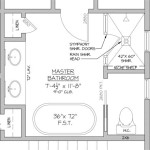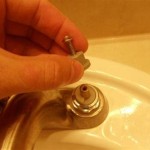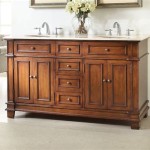Understanding Bathroom Wall Cabinet Depth
Bathroom wall cabinets are essential storage solutions in many homes, offering a space-saving way to keep toiletries, medications, and other bathroom essentials organized and readily accessible. One of the most critical considerations when selecting a bathroom wall cabinet is its depth. The depth of a wall cabinet impacts not only its storage capacity but also its overall aesthetics and functionality within the bathroom space. Choosing the right depth requires careful evaluation of available space, storage needs, and desired design aesthetic.
The depth of a bathroom wall cabinet refers to the measurement from the front of the cabinet to the back, determining how far the cabinet projects from the wall. This dimension directly affects the amount of storage the cabinet can provide. While a deeper cabinet offers more storage, it also occupies more visual and physical space, potentially making a small bathroom feel cramped. Conversely, a shallow cabinet might not provide sufficient storage for all necessary items but can offer a more streamlined and less intrusive presence in the room.
Factors Influencing the Ideal Bathroom Wall Cabinet Depth
Several factors should be considered when determining the appropriate depth for a bathroom wall cabinet. These factors encompass the size and layout of the bathroom, the intended storage needs, and the desired aesthetic style of the space. Neglecting these factors can lead to a poorly chosen cabinet that either overwhelms the bathroom or fails to adequately meet storage requirements.
Bathroom Size and Layout: The size of the bathroom is a primary determinant of the appropriate cabinet depth. In smaller bathrooms, space is often limited, and a shallower cabinet is generally preferred to avoid making the room feel overly crowded. Deep cabinets in small spaces can also impede movement and create a claustrophobic atmosphere. It is crucial to accurately measure the available wall space and consider the proximity of the cabinet to other fixtures, such as the toilet, sink, and shower. Sufficient clearance space should always be maintained to ensure comfortable movement within the bathroom.
In larger bathrooms, greater flexibility exists in terms of cabinet depth. A deeper cabinet can be accommodated without significantly impacting the perceived spaciousness of the room. However, even in larger bathrooms, it is important to consider the overall layout and ensure that the chosen cabinet depth complements the existing design. A cabinet that is disproportionately deep compared to other fixtures can still appear visually unbalanced.
Storage Needs: Assessing storage needs is another crucial step in determining the ideal cabinet depth. Consider the types and quantities of items that will be stored within the cabinet. If the primary purpose of the cabinet is to store small items, such as medications, toothbrushes, and small toiletries, a shallower cabinet might suffice. However, if larger items, such as bottles of shampoo, hair styling tools, or extra towels, need to be accommodated, a deeper cabinet will be necessary.
It is also beneficial to consider the organization of the cabinet interior. Adjustable shelves can maximize usable space and allow for customization based on the size and shape of the items being stored. Drawers within the cabinet, while adding complexity and potentially reducing overall storage volume, can be useful for organizing smaller items and preventing clutter. The configuration of the cabinet interior should be carefully considered in conjunction with the cabinet depth to ensure optimal functionality.
Aesthetic Style: The aesthetic style of the bathroom also plays a role in determining the appropriate cabinet depth. In minimalist or contemporary bathrooms, a sleek, shallow cabinet often complements the clean lines and uncluttered aesthetic. A shallow cabinet can blend seamlessly into the wall, creating a streamlined and unobtrusive appearance. Conversely, in more traditional or ornate bathrooms, a deeper cabinet with decorative detailing might be preferred to enhance the overall visual appeal of the space.
The finish and hardware of the cabinet should also be considered in relation to its depth. A cabinet with a dark finish and ornate hardware will typically appear more substantial than a cabinet with a light finish and minimalist hardware. Therefore, in smaller bathrooms, it might be preferable to opt for a shallower cabinet with a lighter finish to avoid creating a visually heavy or overwhelming effect.
Standard Bathroom Wall Cabinet Depths
Bathroom wall cabinets are available in a range of standard depths, with the most common options typically falling within the range of 4 inches to 12 inches. While these are standard dimensions, custom cabinets can be fabricated to accommodate specific requirements. Understanding these standard depths can help in making an informed decision during the selection process.
4-6 Inches: Cabinets in this depth range are considered shallow and are best suited for storing small items, such as medications, toothbrushes, and other personal care products. These cabinets are ideal for small bathrooms where space is limited and a minimalist aesthetic is desired. Shallow cabinets often feature mirrored doors, which can further enhance the perceived spaciousness of the room.
7-9 Inches: This is a mid-range depth that offers a balance between storage capacity and space-saving design. Cabinets in this range can accommodate slightly larger items, such as bottles of shampoo and conditioner, while still maintaining a relatively low profile. They are a versatile option that can be used in a variety of bathroom sizes and styles.
10-12 Inches: Cabinets within this depth range offer the greatest storage capacity and are suitable for storing a wide range of items, including extra towels, hair styling tools, and larger toiletries. These cabinets are best suited for larger bathrooms where space is not a primary concern. Deeper cabinets can also be used to create a more substantial and visually impactful focal point within the bathroom.
Impact of Depth on Functionality and Accessibility
The depth of a bathroom wall cabinet directly impacts its functionality and accessibility. A poorly chosen depth can lead to difficulties retrieving items, limited storage capacity, and an overall decrease in the usability of the cabinet.
Accessibility: A cabinet that is too deep can make it difficult to reach items stored in the back. This is particularly true for individuals with limited reach or mobility. Shallow cabinets, on the other hand, offer improved accessibility as all items are readily within reach. When selecting a cabinet depth, it is important to consider the height at which the cabinet will be mounted and the reach capabilities of the individuals who will be using it.
Storage Organization: Deeper cabinets can be more challenging to organize effectively. Items can easily become lost or forgotten in the back of the cabinet, leading to clutter and wasted space. Proper organization is crucial to maximizing the usability of a deep cabinet. This can be achieved through the use of drawer dividers, shelf organizers, and clear storage containers.
Door Swing Clearance: The depth of the cabinet also impacts the clearance required for the door to swing open. Deeper cabinets require more clearance space in front of the cabinet to allow the door to fully open without obstructing movement within the bathroom. This is particularly important in small bathrooms where space is limited. Bi-fold or sliding doors can be considered as an alternative to traditional swing doors to minimize the required clearance space.
In summary, the selection of the appropriate bathroom wall cabinet depth is a critical decision that should be based on a careful evaluation of bathroom size, storage needs, and aesthetic preferences. Understanding the standard depths available and their impact on functionality and accessibility is essential for creating a well-organized and visually appealing bathroom space. Careful consideration of these factors will ensure that the chosen cabinet not only meets storage requirements but also enhances the overall design and usability of the bathroom.

Ktaxon Bathroom Wall Cabinet Kitchen Medicine Storage With 2 Mirror Doors And Shelves White Finish Com

Building Wall Hung Bathroom Cabinet Set V750 0098 M1 Axent

Cubilan 21 1 In W X 8 D 24 H White Bathroom Over The Toilet Wall Cabinet B07gfh2y3r Home Depot

Wellfor Cy Bathroom Cabinet 23 5 In X 28 8 White Wall The Cabinets Department At Com

Wall Cabinets 27 W X 29 H 8 D Mounted Bathroom Gkw Retail

Merton Bathroom 1500mm Grey Wall Hung Furniture Tall Storage Cabinet Unit

Kitchen Bathroom Cabinet Construction Wall Cabinets Part 1

Dracelo 21 1 In W X 8 D 24 H Over The Toilet Bathroom Storage Wall Cabinet With Adjustable Shelves White Lw22550 Home Depot

How High Should A Bathroom Cabinet Be Hung Over The Toilet

Wellfor 13 5 In W X 6 D 21 H Bathroom Wall Cabinet With Single Mirror Door White Hw Hwy 65846wh The Home Depot
Related Posts







